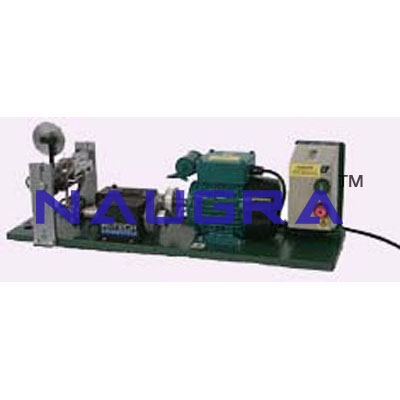- Civil Lab Mechanical Lab Engineering Lab Equipments
- sales@didacticlabequipments.com

CAT NO: DIDACTICNLE-Export-053019
Alternating Bending Fatigue Machine- Engineering Lab Training Systems.
Features
Self-contained
Bench-mounted
Fully guarded
Digital readout of revolutions to failure
Determination of gauge factor
Motor stops when specimen fails
Specimens from strips of plastics or metals
Special setting details supplied
Optional extra for rotating fatigue
Three year warranty
Range of Experiments
Bending fatigue of a cantilevered strip of metal or plastic in modes varying from alternating to fluctuating stresses
The
accessory HSM20X allows an introductory study of fatigue using a Wohler
rotating fatigue test, including time to failure caused by various
stress levels and materials
Description
To extend the range
of fatigue testing to strips of plastic or metal, this variant of the
popular rotating fatigue machine HSM19 has been developed. Using the
drive mechanism and base plate of the new HSM19 Mk.3 with a heavy steel
portal straddling the width of the base an alternating displacement can
be imposed on the free end of a cantilever. The frequency of the
reciprocating force is around 24Hz for plastics or 100Hz for metals.
A
rotating faceplate carries an adjustable eccentric bearing driving a
connecting rod attached to the cantilever. The bridge to which this test
piece is clamped can be adjusted vertically so that the imposed
displacement can be varied. A counter with a 50:1 reduction gear is
driven by the electric motor, offering a 1:100 or 1:25 count depending
on the drive ratio to the faceplate. Microswitches detect failure of the
specimen and stop the motor.
To test a specimen a special dial
gauge enables a calculated deflection to be set for the actual maximum
bending stress of the specimen. An instruction manual containing a set
of nomograms is provided to assist the user.
Great care has been
taken to minimise extraneous vibration. All moving parts are shielded
within a protective cover which can be removed during setting up. A
guard surrounds the connecting rod to prevent damage when the specimen
breaks.
It is possible to add extra parts (HSM20X) to this
machine so that the rotating fatigue test can be carried out as an
alternative.
This equipment is part of a range designed to both
demonstrate and experimentally confirm basic engineering principles.
Great care has been given to each item so as to provide wide
experimental scope without unduly complicating or compromising the
design. Each piece of apparatus is self-contained and compact. Setting
up time is minimal, and all measurements are made with the simplest
possible instrumentation, so that the student involvement is purely with
the engineering principles being taught. A complete instruction manual
is provided describing the apparatus, its application, experimental
procedure and typical test results.
